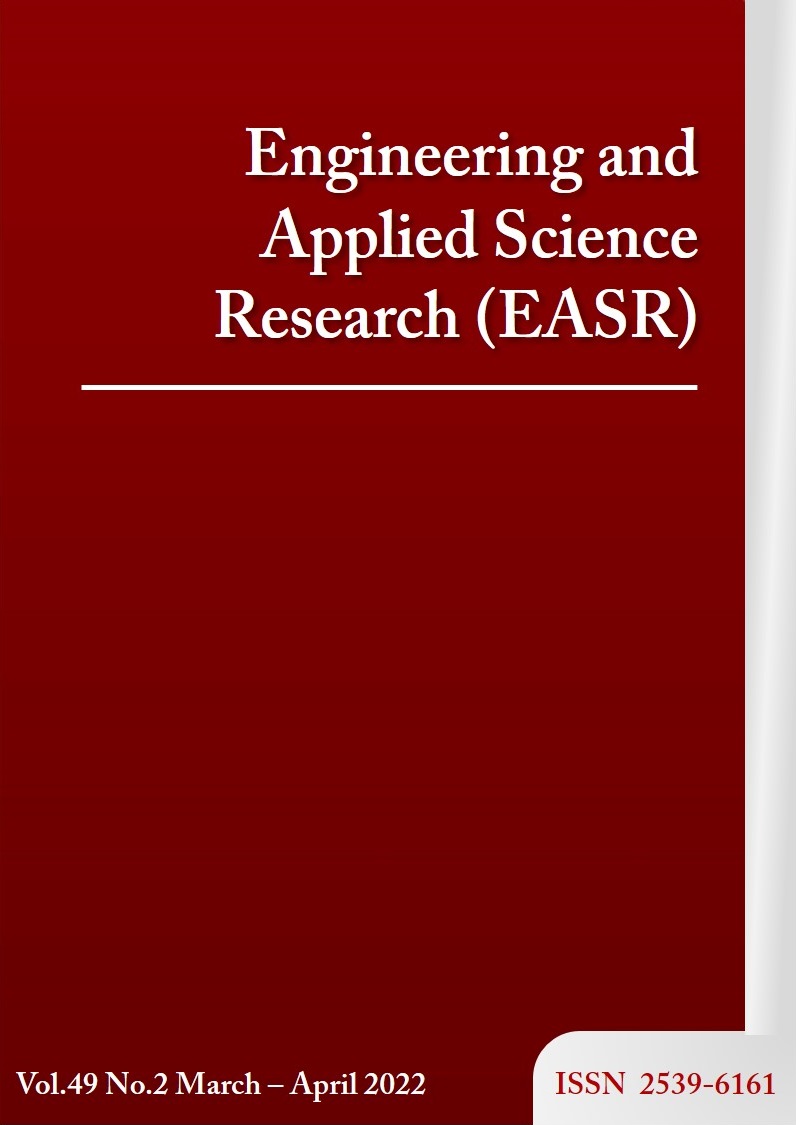Evaluation of GNSS positioning accuracy from satellite-based augmentation systems in Thailand
Main Article Content
Abstract
Satellite Based Augmentation System (SBAS) provides correction message services as an additional system to navigation satellites. Several SBAS services exist in many regions and usually cover a large area. Although, Thailand is not geographically located within a center of SBAS service coverage, users in Thailand can still receive correction messages from some available systems. This study aims to evaluate the GNSS positioning accuracy with corrections from different operational SBAS systems; namely, SPAN, GAGAN and BDSBAS when its positioning strategy is Single Point Positioning (SPP). The positioning results are then compared with solutions from Precise Point Positioning (PPP) which are referred to as reference coordinates. GNSS observations in this study are taken from 40 GNSS Continuously Operating Reference Stations (CORS) operated by the Royal Thai Survey Department. Certain period observations; comprising of September 2019, December 2019, and April 2020, are selected into computations. This research shows that three SBASs could not significantly improve both horizontal and vertical positioning accuracy comparing with GPS Single Point Positioning solutions.
Article Details
This work is licensed under a Creative Commons Attribution-NonCommercial-NoDerivatives 4.0 International License.
References
Satirapod C, Homniam P. GPS precise point positioning software for ground control point establishment in remote sensing applications. J Survey Eng. 2006;132(1):11-4.
Panumastrakul E, Simons W, Satirapod C. Modelling post-seismic displacements in Thai geodetic network due to the Sumatra-Andaman and Nias earthquakes using GPS observations. Surv Rev. 2012;44(324):72-7.
Mustafar MA, Simons WJF, Tongkul F, Satirapod C, Omar KO, Visser P. Quantifying deformation in north borneo with GPS. J Geodes. 2017;91(1):1241-59.
Suwantong R, Srestasathiern P, Satirapod C, Chuang S, Kitpracha C. Mean atmospheric temperature model estimation for GNSS meteorology Using AIRS and AMSU data. Eng Appl Sci Res. 2017;44(1):46-52.
Trakolkul C, Satirapod C. Variations of precipitable water vapor using GNSS CORS in Thailand. Surv Rev. 2021;53(376):90-6.
Charoenphon C, Satirapod C. Improving the accuracy of real-time precipitable water vapour using country-wide meteorological model with precise point positioning in Thailand. J Spatial Sci. In press 2020.
Trakolkul C, Satirapod C. Analysis of PWV derived from the GNSS CORS stations for determining the onset of the southwest monsoon in Thailand. Int J Geoinformatics. 2020;16(2):71-8.
Charoenkalunyuta T, Satirapod C, Keitniyomrung V, Yomwan P. Performance of network-based RTK GNSS for the cadastral survey in Thailand. Int J Geoinformatics. 2019;15(3):13-9.
Thongtan T, Tirawanichakul P, Satirapod C. Precise receiver clock offset estimations according to each global navigation satellite systems (GNSS) timescales. Artif Satellite. 2017;52(4):99-108.
Pothikunkupatarak N, Thongtan T, Satirapod C. Estimations of GNSS receiver internal delay using precise point positioning algorithm. J Appl Geodes. 2019;13(1):41-6.
Rizos C. Principles and practice of GPS surveying. Kensington: School of Geomatic Engineering, University of New South Wales; 1997.
Satirapod C, Rizos C, Wang J. GPS single point positioning with SA off: how accurate can we get?. Surv Rev. 2001;36(282): 255-62.
Ernst & Young Global Limited. SBAS Test-bed demonstrator trial economic benefits report. Australia: EY; 2019.
Choy S, Kuckartz J, Dempster A, Rizos C, Higgins M. GNSS satellite-based augmentation systems for Australia. GPS Solut. 2017;21(3):835-48.
Dammalage D, De Silva D, Satirapod C. Performance analysis of GPS aided geo augmented navigation (GAGAN) Over Sri Lanka. Eng J. 2017;21(5):305-14.
Pungpet P, Kitpracha C, Promchot D, Satirapod C. Positioning accuracy analyses on GPS single point positioning determination with GAGAN correction services in Thailand. Proceedings of 15th International Conference on Electrical Engineering/ Electronics, Computer, Telecommunications and Information Technology (ECTI-CON); 2018 July 18-21; Chiang Rai, Thailand. 2018. Thailand: ECTI; 2018. p. 724-7.
Wu J, Wang K, El-Mowafy A. Preliminary performance analysis of a prototype DFMC SBAS service over Australia and Asia-Pacific. Adv Space Res. 2020;66(6):1329-41.
Li R, Zheng S, Wang E, Chen J, Feng S, Wang D, et al. Advances in BeiDou navigation satellite system (BDS) and satellite navigation augmentation technologies. Satell Navig. 2020;1:1-23.
Dautermann T. Civil air navigation using GNSS enhanced by wide area satellite based augmentation systems. Progr Aero Sci. 2014;67:51-62.
Pringvanich N, Satirapod C. Performance of SBAS algorithm through the implementation of the Asia-Pacific GNSS test bed: initial study in Thailand. J Navigation. 2007;60(3):363-71.
Pringvanich N, Satirapod C. Flight test results and analysis of SBAS-like algorithm from the implementation of the asia-pacific GNSS test bed. Aeronaut J. 2009;113(1139):35-40.
Satirapod C, Khasuwan P, Vongsantivanich W, Chaimatanan S, Jackson R, Biegert D. Preliminary results obtained from the 2nd generation dual frequency multi-constellation SBAS in Thailand. Proceedings of 27th IUGG General Assembly; 2019 July 8-18; Montreal, Canada; 2019.
European GNSS Agency. GNSS User technology report issue 3. Czech Republic: Office of the European Union; 2020.
Liu C, Zhu W, Xu A, Kong Y, Jiang Y, Hu C. Performance evaluation method for ionospheric grid information of BDS via dual-frequency observations. IOP Conf Earth Environ Sci. 2019;237(6):062004.
Bao J, Li R, Liu Y, Lui Y, Shao B. Ionospheric anomaly detection to support the BDSBAS. IEEE Access. 2019;8:1691-704.
Chen S, Jin B, Li D, Qu P. Study on the prediction method of single and dual frequency service area for BDSBAS. In: Sun J, Yang C, Yang Y, editors. Proceedings of China Satellite Navigation Conference (CSNC); 2019 May 22-25; Beijing, China. New York: Springer; 2019. p. 228-37.
Dammalage T. Application of Indian space-based augmentation service on geospatial data collections in Sri Lanka. Surv Rev. 2019;51(369):485-91.
Li W, Zhao D, Shen Y, Zhang K. Modeling Australian TEC maps using long-term observations of Australian regional GPS network by artificial neural network-aided spherical cap harmonic analysis approach. Rem Sens. 2020;12(23):3851.
Federal geographic data committee. Geospatial positioning accuracy standards part 3: national standard for spatial data accuracy. USA: National Spatial Data Infrastructure; 1998.
Takasu T. RTKLIB: An open source program package for GNSS positioning [Internet]. 2013 [cited 2020 April 20]. Available from: http://www.rtklib.com/.
Prakanrattana K, Satirapod C. Comparative study of using different ionosphere models in Thailand for single-frequency GNSS users. Surv Rev. 2019;51(366):213-8.



